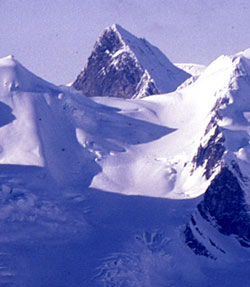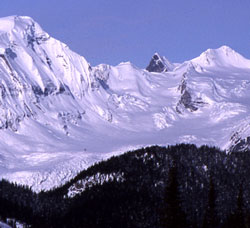
Photo: Looking northwest to Mount Trutch from near Amiskwi Lodge (courtesy Glen Boles)
Mount Trutch
- 3258 m (10,689ft)
- First Ascent
- Naming History
Located on the continental divide at the southern edge of the Freshfield Icefield
Province: Alberta/BC
Park: Banff
Headwater: Saskatchewan/Columbia
Ascent Party: Howard Palmer, J. Monroe Thorington
Ascent Guide: Edward Feuz jr.
Named for: Trutch, Sir Joseph (After travelling from England to join the California Gold Rush in 1849, Joseph Trutch arrived in BC in 1859. He was appointed Lieutenant Governor of the province in 1871
In his book, "The Glittering Mountains of Canada," J. Monroe Thorington described his party's first ascent of Mount Barnard and then the first ascent of Mount Trutch as follows, "Finding ourselves close to the base of Mount Trutch, we decided to ascend it as well. Peculiarly wedge-shaped, this fin-like peak of the Divide had attracted our attention from camp.... On the northeast face of Trutch is a steep hanging glacier, while on the southwest a cliff descends to the snow-basin. A single northwest arete rises like a ridge-pole to the summit, followed by a sheer drop to the ice. The arete itself is of shale and snow, presenting no great difficulty; but the last four hundred feet, invisible from below, turned out to be a knife-edge of rock, which had to be stradddled and took a good hour to negotiate. On the summit , at two o'clock, we piled up a few stones to commemorate our visit. Sir Joseph Trutch is said to have played a leading role in the shaping of British Columbia. He was born and raised in England and trained as a surveyor and civil engineer. After spending time in the United States he returned to England. He then sailed to Victoria upon receiving a recommendation to Governor Douglas of British Columbia to survey lots on the lower Fraser. He then worked on the construction of sections of the Cariboo Road to the Barkerville gold fields. This project involved building the rugged section of the road from Boston Bar to Chapman's Bar. He designed the Alexandra Suspension Bridge that spanned the Fraser river at Spuzzum. In 1864 Trutch was named by Governor Douglas to the position of chief commissioner of lands and works for British Columbia. Trutch wanted to see a Canada united from coast to coast, and played a leading role in British Columbia's entry into Confederation in 1871. Prime Minister John A. Macdonad was so impressed with Trutch that he persuaded him to become B.C.'s first Lietutenant-governer (from 1871 to 1876) after British Columbia became a province of Canada.
